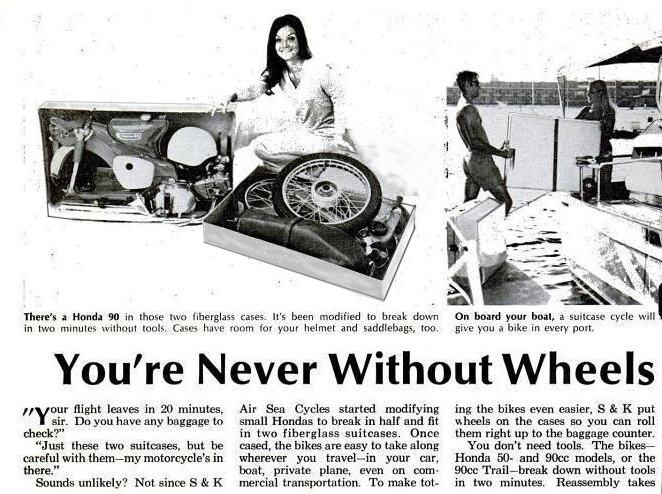 |
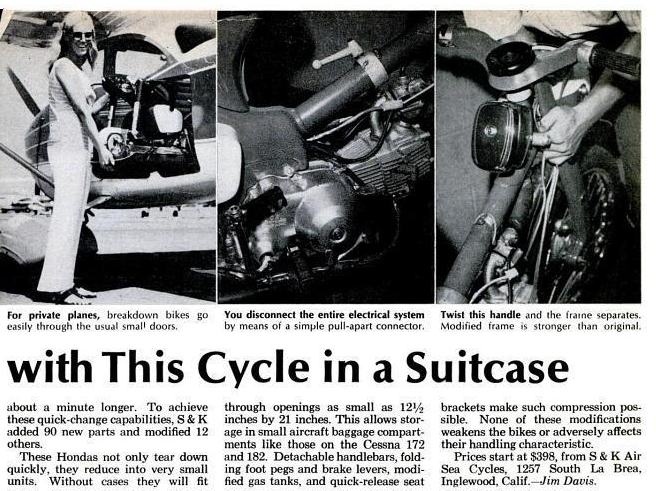 |
The S&K Suitcase Cycle
A light plane is a great way to get around America. I grew up in rural Indiana where my father was a long-time pilot and I got my license while in college. It is a wonderful way to travel. The United States is peppered with thousands of small municipal airports that are convenient to virtually every small town and landing is free. But unlike landing at JFK or Atlanta the place may well be deserted when you arrive. You certainly will not find a row of cabs and shuttle busses waiting to complete your journey. And that is the problem. While your little airplane may get you to the town’s airport, it cannot get you that last few miles to your destination.
S&K in California was aware of this problem and devised the Suitcase Cycle. The idea was to make a motorcycle that would quickly transform itself into a package small enough to fit in the luggage compartment of a light plane. A number of companies had attempted this and the result was usually a small minibike akin to a clown cycle you might see at a circus. Certainly nothing any self-respecting adult would want to arrive on. S&K’s approach was to start with a real motorcycle. They first chose the Honda 50cc Cub, which was all the rage in the early 60’s. They then modified it so it would quickly break apart into pieces small enough to fit in the allotted space. Their concept was moderately successful and they produced a series of these modified bikes for about 20 years using a variety of Honda and Suzuki models. below is an article from Cycle magazine published sometime in the early 60's. The left most panel shows the broken-down pieces packed in the rather large plastic suitcase that came with the bike. The second panel shows a couple carrying the suitcase onto their boat. Of course the packed suitcase weighs as much as the motorcycle. You better be strong. For airplane use you can put the parts in one at a time which is easier.
 |
 |
This particular bike was one of S&K’s first models that used the 50cc Honda Cub. It was bought by a physician here in Mobile who was a pilot and flew a Cessna. He purchased the bike new in the early 60’s and used it for many years. After he passed away his son rode it for a while and then it was finally parked and forgotten about. It was last licensed in 1984. I work with his daughter and one day she asked me if it would be possible to get an old motorcycle that her father used to own running. I agreed to take a look at it. I found it to be a 50cc Honda c100. It was in very rough condition as it clearly had been stored outside for an extended period. It had lots of rust, frozen cables, rotten tires, and a cruddy tank. The dipstick revealed that the motor was completely filled with water and was stuck which meant a total engine rebuild. But this was no ordinary Honda 50. It was in fact a Suitcase Cycle. I had seen advertisements for them in the aviation magazines but never an actual example. Except for the front fender all of the sheet metal was there. When I explained to her the cost and work involved in restoring it she realized that it probably would not be worth it just to see her father’s motorcycle run again.
One of my friends, Mitchell Martin asked her if she would sell it. He explained that he was interested in it strictly as a collectable and after restoring it the bike would stay in town and she could see it any time she wanted. A deal was struck and so the restoration began. The pictures below shows what the bike looked like when purchased.

The motor shown below was full of water and would not turn. Notice the plug that connects the front half of the bike with the rear.

As with all restoration the bike was completely disassembled. All metal chassis parts were sent to Phil Osterkamp in Grand Bay, AL for media blasting to remove paint and rust. I then repainted them with the help of Pat Redding at Atlas body shop in Theodore, AL using base coat/clear coat automotive paint. Aluminum parts were blasted and where appropriate were prepped and polished on a buffing wheel. Several parts like the brake pedal and muffler were sent out for replating.
 |
The wheels were broken down. The hubs were polished and new rims were obtained from Honda (yes they are still in stock). Honda Cubs are still in broad use in southeast Asia and many venders for parts in Thailand and Indonesia can be found on eBay. A set of new spokes were bought from a Thai vender and new tires were found at the Barber Vintage Festival's swap meet. When finished we had a great pair of wheels. |
 |
Reassembly started with the subframe. The centerstand and swing arm were added along with the brake pedal. An old shock was mounted to temporarily hold the swing arm in place. |
 |
The front fork in amazingly complex as hydraulic shocks are contained within them. The shocks were in good shape and were reused. The leading links were carefully lubricated with a grease gun during assembly. Note the split frame section to the right. S&K modifies the frame's downtube by pressing a aluminum splice piece (silver in the picture) into where it was cut in two. The silver end fits snugly into the open end of the downtube seen in the above figure. A heavy clamp holds then tightly together. |
 |
The wheels are added and the front end is attached to the the subframe. notice the large Brass clam that holds the two parts in place. |
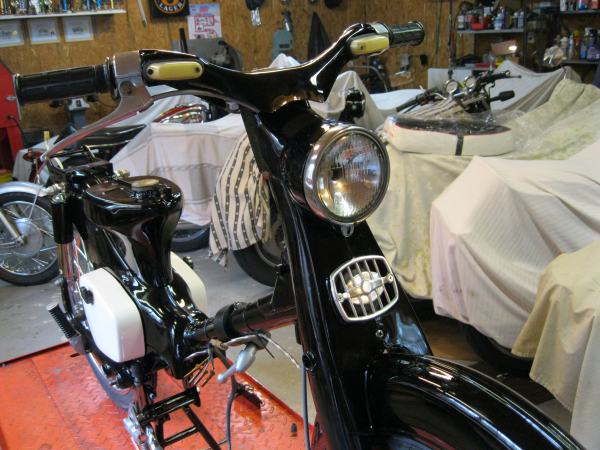 |
Final assembly of the chassis. The wiring harness was in good shape. After careful cleaning and repairing several connectors, it was reinstalled. The headlight was good and the chrome rim cleaned up. The handlebar controls were polished and reassembled using all new cables. The speedometer was cleaned up and worked fine. The speedometer cable was replaced. The horn grill was polished and the original horn still worked. New rear shocks were used as the replacements were cheaper than replating the old ones. The original side covers were made of plastic and were in good shape. Flexible car bumper primer was used on them followed by an automotive white finish. Notice the turn signal lights on the bars. In Asia they were functional but there are no bulb sockets installed in the early American models. The gas tank makes the perch for the seat. |
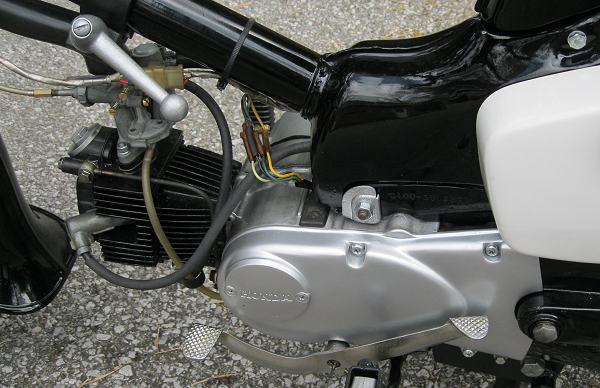 |
The engine was rebuilt with the help of Jim Arrington and Steve Mclintock. When I drained the water out of the motor I got about a quart of clear water followed by another quart of "milk". The air cleaner tube was not attached to the carburetor when it was finally parked so that rainwater drained through it into the motor. Fortunately it was rainwater devoid of salts and there was actually relatively little rust in the motor. All of the transmission parts and the piston were reused. The hardest part was rebuilding the crankshaft. I found a NOS rod kit on eBay that fit. The crank parts however would not rue up. We bought several used cranks from eBay before we found one that had true crank halves. Steve Mclintock did the crankshaft work. New clutch plates were also used. |
Below you can see the final result. The sticker on the downtube identifies it as a Suitcase Cycle and was reproduced by a local instant sign company.
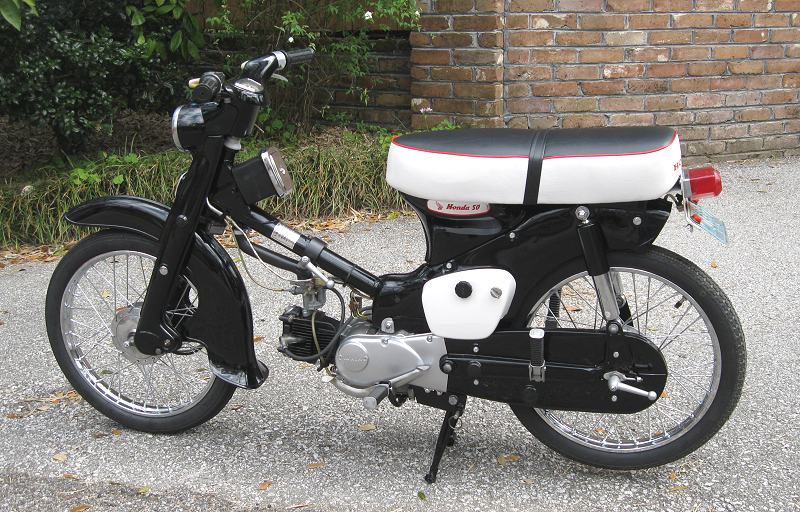
The right side is shown below.
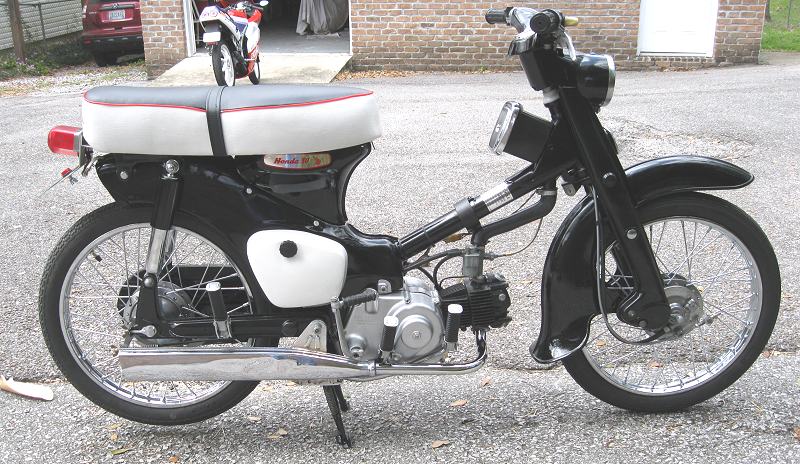
S&K's modifications from the original Honda Cub can be appreciated from the pictures. The muffler and rear fender were cut to be even with the rear of the swing arm. The tail light was them moved to the seat. The seat and tail light can be removed when unlatched and hinged up. The plug for the tail light can be seen in the top figure. The front end can be detached by unplugging the electrical connector seen near the downtube clamp, unscrewing the carburetor cap, unhooking the breather tube, and loosening the downtube clamp (see above picture). Then the Rear wheel is removed by loosening the special axel nut (see right side picture), sliding out the axel, and then removing the wheel. The chain and sprocket remain in place. Several other modifications can bee seen. The footrests and brake pedal fold to reduce the overall width of the frame assembly (see right side picture). Finally, the original Honda Cub had plastic splash guards which are not used by the suitcase cycle. For those not familiar with the Honda 50, it has an automatic clutch and a 3 speed transmission which must be manually shifted. Top speed is somewhere around 40 MPH.